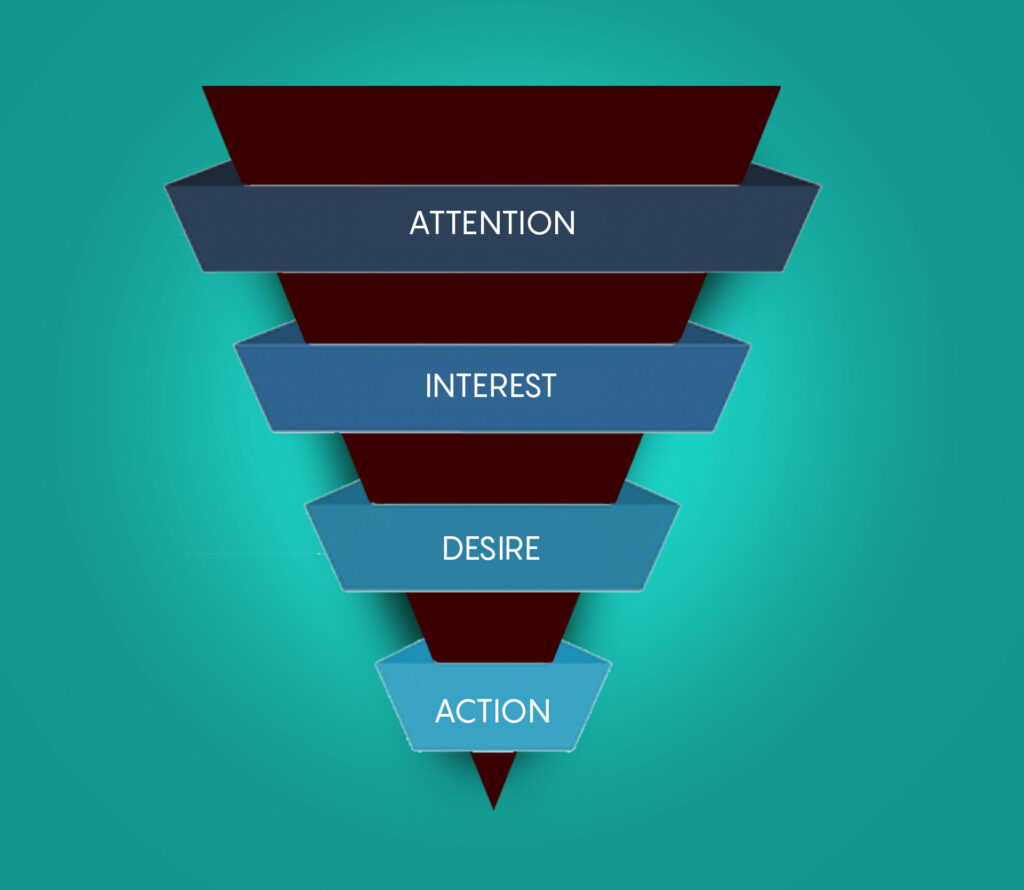You cannot build a house unless the cornerstones have been laid and the foundation happens to be solid. The same applies to building your business on half-baked marketing theories. To truly understand how to successfully orient your business in today’s economy, you need to go back to basics and establish that strong foundation in said strategy.
There are so many models and theories when it comes to marketing and advertising nowadays. The AIDA model is different, think of it as the ancestor to most of today’s modern advertising concepts. The chances are you heard about this in school, the fact is, the model is still relevant and in use to this day!

What Is The AIDA Model?
It is an advertising model, that is to say, it helps marketing agencies and businesses identify the level of engagement that customers have with their products. The model in itself lays out the different stages that an individual most likely goes through during the process of purchasing a particular product or engaging in a service. Here is the breakdown of the acronym:
A – Attention
This is the first step in the model, which states that attracting the customers’ attention is the key to begin the engagement and purchasing process. This is usually done through some sort of advertisement.
I – Interest
Piquing a customer’s interest is the intermediary stage. Where the first stage grabs their attention, this one gives them a reason to stay interested.
D – Desire
Now that you have their interest in the product or service, it is time to make them want it. Nudge them into a mindset that urges them to buy it.
A – Action
The final stage of the process is getting them to go to the store and execute the action of buying the product or service, as is the goal of every marketing campaign.
‘‘
AIDA is a tried and true model that maintains relevance even in today's market situation.
The History And Relevance Of The Model
The AIDA model was first brought into this world by the American businessman, E. St. Elmo Lewis, in 1898. His aim was to create a simplified model that could determine the ideal level of engagement by the customer. He used the scientific method to create this model which illustrates the most effective way to conduct sales and advertising.
The main purpose of the AIDA model was to optimise the sales calls and maximise the interactions between the seller and buyer when it concerned a product or service.
How To Apply It In Your Marketing
In theory which has been proven in practice over the years – if you structure your marketing campaign with the AIDA model in mind, it provides more control over the path the customer takes when purchasing. As they progress through each stage of the model it subtly pushes them more and more towards purchase. It is so subtle in fact that most of the time customers will feel like it was completely their choice to have purchased it. If you think about it, the model really is a very effective psychological tool.
Here Is How You Can Implement AIDA In Your Business Model:
Attracting attention
The attention-grabbing aspect is taken for granted by many in the marketing industry. Do not just assume that everyone is aware of the existence of your product. To grab the customers’ attention is to deeply engage with them and this creates curiosity. The most effective way to do this is to be loud, colourful, unique and actively break existing visual patterns (especially in print advertisements).
For example, place your ads in unusual but active locations like a subway station or bus stand. Make it stand out with some thought-provoking images that may shock the audience. You can even place a highly targeted message at a specific demographic based on the nature of your product or service.
Creating interest
This is usually the hardest part of the process where you have to push the audience from “I see it,” To “I like what I see.” Once they see it, they should want to learn more about the brand and the product. This type of interest can be hard to cultivate if the product or service is not particularly interesting. To achieve this interest try sticking to the meat of the message, that is to say, have a clear-cut message that compliments the best aspects of the product and tells them why it is useful.
A good example of this is a McDonald’s advertisement which had nothing but a billboard with two lights shining down and creating a shadow outline of the signature ‘M’ with the words “OPEN AT NIGHT” on the board. This combination of creative visuals and simple message focuses on the 24/7 availability of the fast-food brand.
Building desire
The interest and desire aspect go hand-in-hand if you think about it. This is more of the tail end of that process. You push them from “I like it,” to “I NEED it.” A good rule of thumb to maintain is that people only buy products that they trust. So, establish trust with consistent content.
For example, if you look at infomercials, they consistently put the product in various creative situations that test the limits and uses of the products, showing the audience how versatile and useful it is. This shows the trust aspect of it. Then the message of how it makes their lives easier fulfils the needed aspect of the message.
Taking action
The last step is to get the customer to go out and make the purchase. If you did all your other steps right, this should be the easiest part. A good way to do this is to have a subtle call to action on your advertisements.
Streaming services for example, like Netflix and Amazon Prime, call their audience to action by giving them free trial periods to see if they like the services being provided. It literally would cost nothing to try it, and given the benefit of having access to the latest shows without that cost is all the reason the audience needs.

Other Uses For AIDA
The simplicity of the model allows for flexible use in various other areas of a business apart from just marketing and sales. For one, it can be and is actively used in public relations planning and campaigns. It can also be used in e-commerce platforms to map and measure the effectiveness of products according to the four steps.
Some Shortcomings And Criticisms Of The Model
Nothing is perfect. For the majority of its lifespan, the AIDA model has been viewed as a golden rule of marketing but in recent years the general consensus seems to be that it is too rigid. Yes, it is actively used in many areas of business even today and will likely continue to be used. However, many economists feel it is outdated when put into the context of today’s economic environment.
For one, it fails to address the emotions of the audience. It also does not consider other important factors such as socio-economic backgrounds or other demographic data. At the other end of the line of criticism, the step-by-step sequence of the model is seen as too linear for today. It assumes that the four-step AIDA model is exactly what a potential customer might follow, but in reality, the sales process does not always follow this format.
It is for this very reason that we nowadays see variations and branch-offs of the classic AIDA model. Some examples include:
- AIDCAS (Action, Interest, Desire, Confidence, Action and Satisfaction)
- REAN (Reach, Engagement, Activate and Nurture)
- NAITDASE (Need, Attention and Interest; Trust, Design and Action; Satisfaction and Evaluation)
‘‘
Though there are certain limitations to the AIDA model, the modern versions of can help converge on those gaps and give you a good foothold in the marketing game.
These branch-offs come as a result of the AIDA model being viewed as too simplistic and the failure to consider the above-mentioned nuances when considering the sales process. In today’s circumstances – given the various forms in which sales and marketing can take place – every customer experience can and will vary, be it online or in person or through social media platforms.
Having said that, it is still a very relevant model, despite what economists might say as it is one of the cornerstones upon which modern advertising principles are built and can still be practically used in the modern context. Although it does not represent the entire purchase and sales process it does serve as a good tool for ‘customer journey mapping’ and setting the stage of how the customer might go about engaging with a brand.




